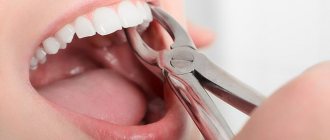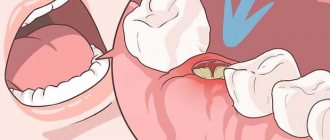How to rinse your mouth after tooth extraction
Removal of a tooth
– an unpleasant but necessary surgical operation.
It is prescribed when the tooth
can no longer be saved.
Removal
usually does not last long, a couple of minutes, after the anesthesia has taken effect. However, after the intervention, especially if we are talking about the sixth, seventh or eighth tooth (also called wisdom teeth), the wounds remain large and deep and sometimes take a long and difficult time to heal. Therefore, in order not to introduce an infection into the postoperative space and not to provoke inflammation, you need to help yourself, you need to behave correctly.
What not to do after tooth extraction
During the first time after tooth extraction
absolutely
not allowed
:
- Touch the wound hole
with toothpicks, hard bristled brushes and other foreign objects. - There are fermented milk products. This is an excellent breeding ground for bacteria to grow.
- Go to the gym, swimming pool and bathhouse, including the sauna.
- Drink something hot and warm the wound with something.
- Chew on the side of the mouth where the tooth was removed.
- Smoking.
How to rinse your mouth after tooth extraction -
The most important rule is that you should never make intense rinsing movements. The fact is that immediately after tooth extraction, the socket is filled with blood, which normally coagulates almost immediately, forming a blood clot (Fig. 1-2). The blood clot also performs a protective function, preventing bacteria and food debris from entering deep into the wound. During the first few days, the clot is quite weakly attached to the bone walls of the socket, and therefore, if you rinse your mouth vigorously, the clot may fall out.
The loss of a blood clot from the socket will lead to bacteria and food debris getting deep into the socket. As a result, inflammation of the socket of the extracted tooth will occur, which dentists call “alveolitis.” Therefore, the right thing to do is either weak rinses (without active movements), or generally only antiseptic baths. The latter is that you must draw an antiseptic solution into the oral cavity, hold it for 30-60 seconds (without rinsing) and then spit it out.
What does the socket of an extracted tooth look like?
Thus, on the one hand, antiseptic rinses of the mouth after tooth extraction help prevent inflammatory complications (for example, suppuration of a blood clot and the development of alveolitis of the socket). Suppuration of a blood clot is possible in the following cases - 1) if the tooth was removed due to inflammation, 2) after a complex tooth extraction, 3) if there is a lot of soft microbial plaque, hard dental plaque or untreated carious teeth in the oral cavity.
In all these cases, antiseptic rinses (sometimes prescribed in combination with antibiotics) help prevent suppuration of the blood clot and the development of alveolitis in the socket of the extracted tooth. But on the other hand, if rinsing is carried out incorrectly, then, on the contrary, this can lead to the development of inflammation of the socket of the extracted tooth. Below you can see one of the options of what inflammation of the socket of an extracted tooth may look like (24stoma.ru).
Alveolitis of the socket of an extracted tooth –
If you look at Fig. 3-4, you will notice that in the depths of the socket traces of necrotic disintegration of a blood clot and food debris are visible, and the bone walls of the socket are exposed. Accumulations of microbial plaque are visible on the teeth. Typically, such inflammation of the socket is accompanied by an unpleasant odor from the mouth, and swelling of the gums may appear. The pain can be from moderate to very severe, and it tends to increase when hot or cold water enters the hole. Let's now figure out what to rinse your mouth after tooth extraction.
What to do after tooth extraction
As mentioned above, wounds heal especially difficult after removal
teeth sixth seventh and eighth teeth.
The gums hurt and bleed
, sometimes for a long time and profusely.
However, it is better not to touch the wound for the first two days - a blood clot should form, which will promote healing and delay the infection. Unpleasant sensations can be relieved with painkillers. Sometimes during this period, dentists advise taking antibiotics to eliminate the inflammatory process. Two days after tooth extraction,
you need to start rinsing the wound. This will also facilitate the restoration processes in the gum tissue.
Features of rinsing the tooth after removal with soda
After tooth extraction, a deep wound remains. The first treatment is carried out by a dentist, disinfecting medications are used. Within a few hours, a dense blood clot forms on the wound, protecting the tissue from infection, dirt, and bacteria no worse than powerful medications.
Rinsing can wash away the natural barrier, so doctors do not recommend carrying out the procedure during the first 24 hours. Be sure to monitor the condition of the wound - if signs of inflammatory processes are noticed, begin manipulations using soda solutions earlier.
Expert opinion
Carefully!
Manipulations are recommended to be carried out carefully. Even if you use a composition in which the main component is baking soda, when rinsing, try not to disrupt the integrity of the blood clot. You should not vigorously roll the liquid in your mouth - this will inevitably lead to the displacement of the blood plug; it is better to just hold the solution in your mouth.
Be sure to use room temperature products. If the composition has cooled down, put it on the stove and heat it up. Perform wound disinfection procedures immediately after mixing the home remedy. Even short storage is enough for sodium bicarbonate to lose some of its medicinal properties.
Recommended for you:
How to treat brain cancer with soda solution at home
After the procedures, avoid eating solid, hot foods. Food particles will cause additional pain and dislodge the clot that protects the wound. Alcohol is no help here - alcohol will cause pain.
What to rinse with?
Keep in mind that you don't need to literally rinse your mouth.
, and arrange a therapeutic bath for the wound left
after tooth extraction
. So eliminate the efforts that create seething, so as not to damage the first healing processes.
- First aid
in this case is a solution of a teaspoon of salt and the same amount of soda in a glass of warm water. They are in every home. This rinse should relieve pain and disinfect the wound hole. - At the Pharmacy
you can always stock up on furatsilin to disinfect a sore spot. The solution requires one tablet per glass of water. A solution of chlorhexidine (0.05%) or miramistin is also suitable. The latter remedy also has a good analgesic effect. All medications are very inexpensive.
Many anti-inflammatory and disinfectant herbs, as well as those that have a healing effect, are suitable from your grandmother’s herbalist They are prepared in approximately the same way - cook a little for 15 minutes in a water bath, strain, cool and rinse. Chamomile, calendula, sage and eucalyptus are better suited than others, and it is better to use all at the same time in equal shares. You can also use St. John's wort, oregano and pine needles.- If
swelling
occurs the tooth was removed , then briefly apply ice to the sore spot and rinse the hole with soda and furatsilin. - If the pain occurs after removing the nerve of the tooth
, then rinsing with propolis infusion and the same soda solution, but with a few drops of iodine, helps a lot.
If after several days the pain does not subside, the bleeding does not stop, and any additional unpleasant symptoms arise, you should definitely seek help from a dentist. Another piece of advice: if you know that you have poor blood clotting, notify the surgeon about this and ask him to sew up the wound, having first put the medicine in the hole. This will facilitate and speed up the healing of the gums.
Soda-saline solution for gum inflammation
Expert opinion
Advice!
Infection in the wound, accompanied by inflammatory processes, is a reason to use a more aggressive agent. The combination of regular salt and NaHCO3 will stop the spread of infection, get rid of accumulations of pus, and relieve pain.
The first manipulations are unpleasant - the composition causes pain, so after using the product, rinse your mouth with plain warm water.
Preparation of the product, recipe:
- Mix salt (15 g), sodium bicarbonate (15 g).
- Pour warm water (200 ml) into the bulk mixture.
- Stir until the salt crystals completely disappear (they can cause irritation and damage the tissues of the oral cavity).
Rinse without vigorously rolling the liquid. Leave the solution on the affected area for a few seconds.
Recommended for you:
Why and how athletes take soda
Repeat the procedures 3-6 times a day. If after manipulation the blood clot begins to wash out and break down, reduce the number of procedures. Additionally, using brilliant green or iodine for cauterization is prohibited - this will lead to the formation of a burn to delicate sensitive tissues.
Is it possible to rinse and when to do it?
A day after tooth extraction, rinsing is acceptable in some situations, but these are more likely to be oral baths than active washing procedures.
Few people have an oral cavity in perfect condition. Caries, loose teeth, plaque and stones, and often rotten tooth roots are not the best neighbors for the bleeding surface of the alveoli. Mouth baths will reduce the risk of infection penetrating deep into the socket.
When carrying out a hygienic procedure aimed at combating inflammation, you should remember:
- active rinsing movements will do more harm than good;
- For the first 24 hours, limit yourself to gentle brushing of your teeth;
- if pain occurs during the procedure, rinsing should be stopped;
- If bleeding resumes, visit a doctor immediately.
In addition, do not forget the dentist’s recommendations: do not eat hot food, do not lift heavy objects, and do not touch the socket with your hands and tongue.
Properties and benefits of soda for teeth - the principle of action of mouth rinse
Baking soda will help relieve toothache.
Baking soda does not have a negative effect on tooth enamel. A rinsing composition based on it has the following beneficial properties:
- has an antiseptic effect, eliminating pathogenic microorganisms;
- whitens the surface of teeth;
- relieves pain;
- makes breath fresh;
- reduces the severity of the inflammatory process.
Important! A composition with a weak concentration of soda can be used even during the period of teething in infants. To relieve pain, this product is lubricated on the gums and tongue.
Water with soda dissolved in it has a pronounced antiseptic effect and also suppresses pain. This product is non-toxic and safe for teeth and mucous membranes of the oral cavity.
Indications for hygiene procedures with soda
Baking soda will help get rid of a number of oral problems.
The use of a special liquid for treating teeth is indicated in the following cases:
- for pain in teeth of various origins;
- to remove pathogenic microorganisms that enter the oral cavity along with food and are retained between the teeth;
- to eliminate plaque that lingers on tooth enamel and is caused by prolonged smoking, drinking coffee and strong tea;
- to prevent infections after tooth extraction;
- to prevent the development of inflammatory processes and darkening of tooth enamel, as well as the formation of tartar.
Indications for the use of soda solution are:
- oral candidiasis;
- flux;
- caries;
- stomatitis;
- inflammatory processes of the gums and tongue (gingivitis and glossitis);
- periodontitis.
Note! Despite the harmlessness of water with added liquid, it cannot be used as the main method of therapy: diseases of the teeth and oral cavity must be treated with the assistance of qualified specialists.
Using medications to help gums heal faster
Pharmaceutical preparations for rinsing the mouth are very popular.
- Stomatophyte - it is made using herbal extracts that relieve inflammation. The medicine must be diluted with water to the concentration specified by the manufacturer. The kit includes a measuring cup. The solution does not irritate the mucous membrane, therefore it is suitable for use after tooth extraction;
- Chlorophyllipt – made from eucalyptus extract. For dental purposes, it is often used in the form of an alcohol infusion, so after tooth extraction it should be used carefully to avoid burns;
- Salvin is an alcohol-containing preparation that contains essential oil and tannins. To use for rinsing, the product must be made low-concentrated, diluted with water in a ratio of 1:10. In such a low concentration, the alcohol tincture does not dry out the tissues of the oral cavity. At the first sign of irritation, discontinue use immediately.
Iodine, soda against bleeding
Expert opinion
Attention!
The use of iodine in its pure form after tooth extraction is strictly prohibited, but the combination of baking soda and a pharmaceutical preparation allows you to quickly get rid of bleeding. Painful sensations also effectively disappear after 2-4 procedures performed at home.
Preparation of solution, application:
- Boil water (210 ml), wait until it cools.
- Add iodine (2-5 drops), stir.
- Add sodium bicarbonate (20 g).
It is recommended that manipulations with the solution be carried out every 2-3 hours. Bleeding will decrease in intensity after the first rinse, but there is no need to stop the procedures until the problem completely disappears.
Herbal decoction for rinsing
A decoction of plants will help relieve the painful sensations that arise after a visit to the dentist. To increase efficiency, it is recommended to add NaHCO3. Use a composition based on sodium bicarbonate, despite severe pain, one day after tooth extraction.
Preparation, use:
- Grind dry sage (20 g), rub with your hands, turning it into a fine paste.
- Brew the vegetable pulp with boiling water (240 ml), leave, cover with a lid to obtain a rich decoction.
- Baking soda is added after filtering - 15-18 grams are needed. cooking powder.
It is recommended to prepare a large portion of the broth, adding soda before rinsing. Store the herbal remedy in the refrigerator, heat it up before use, and use the microwave.
If the body reacts negatively to sage, replace the plant with chamomile inflorescences, which have disinfectant and analgesic properties. At the same time as disinfecting the wound, chamomile infusion will relieve pain.










